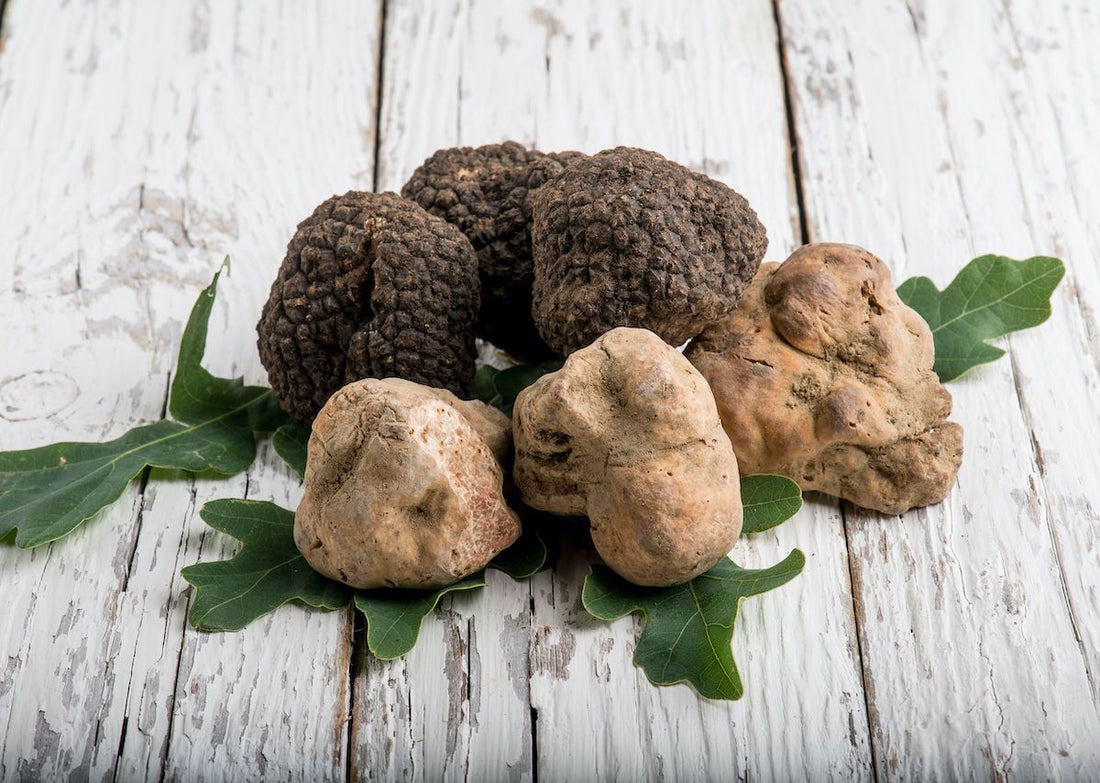
THE DIFFERENCE BETWEEN WHITE & BLACK TRUFFLES
Share
Truffles have long been considered one of the most luxurious ingredients in fine dining. With their rich aroma and deep, complex flavors, they can elevate even the simplest dishes. Among the many varieties of truffles, white truffles and black truffles stand out as the most prized. But what exactly sets them apart? In this guide, we’ll explore the key differences between these two gourmet delicacies, helping you decide which one best suits your palate and culinary needs.
What Are White Truffles?
White truffles (Tuber magnatum) are among the rarest and most sought-after truffle varieties. They are primarily found in Italy’s Piedmont and Alba regions, growing symbiotically with oak, hazelnut, and beech trees. Unlike other fungi, truffles grow underground, making them difficult to find without the help of specially trained truffle dogs.
Appearance & Aroma
White truffles have a smooth, slightly marbled exterior with a creamy, light brown interior. They are highly aromatic, often described as having a pungent yet intoxicating scent reminiscent of garlic, honey, and aged cheese.
Flavor Profile
White truffles boast a delicate, nutty, and slightly garlicky taste. Their flavor is best appreciated when used raw, as cooking can diminish their intense aroma.
Best Ways to Enjoy White Truffles
Since white truffles are so fragrant, they shine in simple dishes where their essence can stand out. Popular pairings include:
- Freshly shaved over pasta (e.g., Truffle Tagliatelle)
- Folded into creamy risotto
- Sprinkled over scrambled eggs or mashed potatoes
- Drizzled as white truffle oil over bruschetta or salads
What Are Black Truffles?
Black truffles (Tuber melanosporum), often called Périgord truffles, originate from France, Italy, and Spain. Unlike their white counterparts, black truffles are slightly easier to cultivate, making them more widely available.
Appearance & Aroma
Black truffles have a rough, bumpy black or dark brown exterior with an interior veined in white. Their aroma is earthy, musky, and slightly chocolatey, with hints of hazelnut and red wine.
Flavor Profile
Black truffles offer a rich, umami-forward taste with deep, savory notes. Unlike white truffles, black truffles maintain their flavor well when cooked, making them a versatile ingredient.
Best Ways to Enjoy Black Truffles
Black truffles pair beautifully with hearty, bold dishes. They can be:
- Grated into sauces and soups
- Mixed into butter for truffle-infused spreads
- Used in black truffle pasta dishes
- Infused into black truffle oil for drizzling over roasted vegetables or meats
White vs. Black Truffles: Key Differences
| Feature | White Truffles | Black Truffles |
|---|---|---|
| Rarity | Very rare | More available |
| Aroma | Pungent, garlicky, cheesy | Earthy, musky, chocolatey |
| Best Used | Raw | Cooked or raw |
| Common Dishes | Pasta, risotto, eggs | Sauces, meats, pasta |
| Shelf Life | Short (must be used quickly) | Longer (more durable) |
| Price | Extremely expensive | Less expensive than white truffles |
Which One Should You Choose?
If you love bold, earthy flavors that can be cooked into dishes, black truffles are an excellent choice. However, if you’re looking for a delicate, aromatic burst of luxury to finish off a dish, white truffles are the way to go.
At Caviar and Truffle, we offer a premium selection of both white and black truffle products, including truffle oils, salts, and fresh truffles. Whether you’re a seasoned gourmet chef or a food lover exploring truffles for the first time, we have something special for you.
Explore our collection and elevate your culinary experience today!
